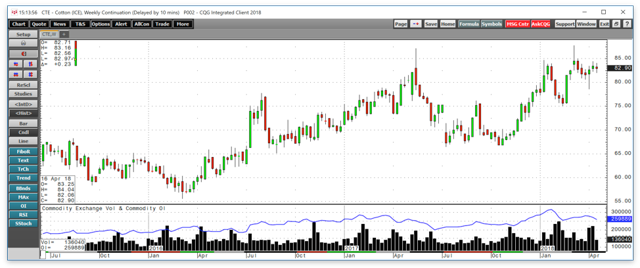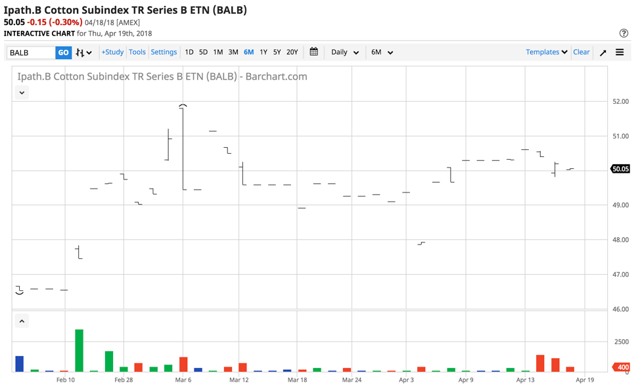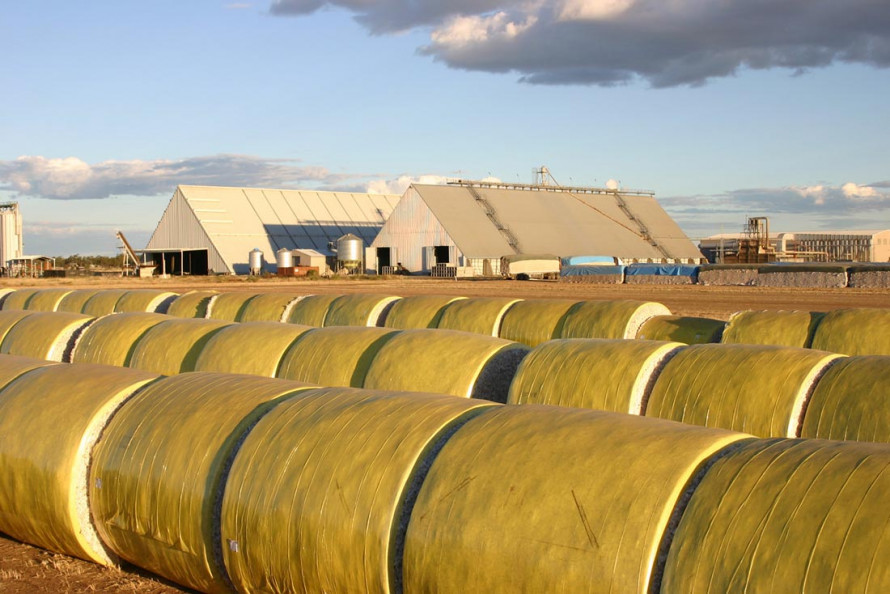Andrew Hecht
Summary
Higher lows for the fluffy fiber.
Tariffs have given the market a reason to pause.
WASDE was bullish.
The next technical level will propel cotton to another level this year.
Cotton is a highly volatile commodity in the world of futures.
In 2011, the price of cotton futures that trade on the Intercontinental Exchange hit their highest price in modern history when the fiber peaked at $2.27 per pound. At the turn of the century, in early 2000 the price of cotton futures was at the 50 cents per pound level, and in 2001 it hit a low of 28.2 cents.
While the price of cotton declined from the 2001 highs to lows of 55.66 cents per pound in March 2016, cotton has been making higher lows since way back in 2001.
Many factors impact the price of cotton. Some producing countries around the world provide subsidies for cotton farmers to help them through periods where the price falls below production cost. Those subsidies distort the typical supply and demand analysis for the soft commodity. This year, the potential for tariffs by the U.S. and retaliation by China could also change the price of cotton. China imports lots of U.S. cotton each year. At the same time, the crop in 2018 will as always be a function of the weather across the major growing areas in the Southern United States. On both a technical and fundamental basis, the price of cotton is entering the period of uncertainty this year on a positive note.
Higher lows for the fluffy fiber
After its plunge from $2.27 in 2011 to 55.66 cents per pound in March 2016, the price of cotton has been in recovery mode.
Source: CQG
As the weekly chart highlights, the price of the fiber has moved appreciably higher and has developed a pattern of both higher lows and higher highs. The most recent peak came in early March of this year when the nearby futures contract that trades on the Intercontinental Exchange hit 87.75 per pound, the highest price level since June 2014 when cotton was on its way down from the record peak price. The weekly chart displays a bullish trading pattern, and rising volume and open interest are a technical validation of the price trend. In the world of futures, when volume and open interest move to the upside with price, it tends to be a supportive factor in the price of a commodity.
Tariffs have given the market a reason to pause
In early April, the price of cotton suddenly corrected lower after reaching its latest peak in March. The price fell to lows of 78.62 cents per pound as tensions surrounding international trade weighed on the price of the soft commodity.
The Trump administration rolled out tariffs on steel and aluminum imports into the United States in March and announced its intention to level $60 billion in tariffs on Chinese goods. China was quick to retaliate with tariffs on U.S. goods. Since China is a significant importer of U.S. cotton, the futures markets became concerned that a lack of Chinese buying could cause stockpiles to increase over coming months and after the 2018 crop year. However, tensions eased recently after President Xi of China made a conciliatory speech in Beijing, and President Trump took the olive branch extended by the Chinese leader. It is probable that the threat of tariffs is a bluff or posturing by both sides to improve their respective positions when it comes to bilateral trade negotiations. Therefore, after trading below the 80 cents per pound level, the price of the fiber futures quickly recovered over recent sessions.
WASDE was bullish
On April 10, the U.S. Department of Agriculture released its April World Agricultural Supply and Demand Estimates report. When it comes to cotton, the USDA reported that exports from the U.S. increased on a month-to-month basis, and stockpiles moved lower while production and mill use remained unchanged. While global production of the fiber grew, and consumption fell over the last month, world stockpiles were adjusted some 600,000 bales lower for the 2017/2018 crop year. All in all, the WASDE report was supportive of the price of cotton which settled on Thursday, April 19, at the 82.97 cents per pound level on the nearby May futures contract.
The next technical level will propel cotton to another level this year
After trading to lows of 55.66 cents in 2016, copper rose above both the 60 and 70 cents level that year as the fiber recovered from the bottom established in March of 2016. In 2017, the price breached the 80-cent level which has been a pivot point for the soft commodity so far this year. Nearby futures fell as low as 75.11 cents and traded to highs of 87.75 cents in 2018.
After the most recent spike to the downside in early April, which made a higher low, and recovery, the fiber now appears to be in a position to challenge the March peak and to test levels above the 90 cents per pound area. A rise to 90 cents or above will keep the pattern of higher highs intact, after the rise from 78.62 cents at the start of April kept the pattern of higher lows intact.
Cotton is a highly volatile commodity in the world of futures
A high degree of price variance is the norm rather than the exception in the cotton futures market.
Source: CQG
As the monthly chart highlights, the current level of historical volatility is below 16%, but it has traded as high as over 60% in 2011 and tends to trade higher than its current level. While the supply and demand fundamentals for the fiber are positive even if the crop this year is abundant, there is always a chance that the weather could intervene and cause a shortage to develop in the coming months. Therefore, fundamentals in the cotton market support a higher price and buying cotton on price dips or corrections could present profitable opportunities on a risk-reward basis for traders and investors.
Source: Barchart
BALB is the new cotton ETN product that replaced BAL this month. BALB has small net assets of only $4.06 million and trades only 400 shares each day as it builds liquidity. BALB was trading at $50.05 per share as of the close of business on Thursday, April 19, and should build traction since it will now attract the volume that used to go to BAL.
Cotton appears to be heading for a test of the 90 cents per pound level in 2018 and any dips over coming weeks could provide an excellent opportunity to buy the fluffy fiber that continues to work its way towards $1, a level that it has not seen since 2011. While fundamentals support the upward trajectory of the price of the soft commodity, a weather issue could propel cotton much higher in a short period.
The Hecht Commodity Report is one of the most comprehensive commodities reports available today from the #2 ranked author in both commodities and precious metals. My weekly report covers the market movements of 20 different commodities and provides bullish, bearish and neutral calls; directional trading recommendations, and actionable ideas for traders. More than 120 subscribers are deriving real value from the Hecht Commodity Report.
Disclosure: I/we have no positions in any stocks mentioned, and no plans to initiate any positions within the next 72 hours.
I wrote this article myself, and it expresses my own opinions. I am not receiving compensation for it (other than from Seeking Alpha). I have no business relationship with any company whose stock is mentioned in this article.
Additional disclosure: The author always has positions in commodities markets in futures, options, ETF/ETN products, and commodity equities. These long and short positions tend to change on an intraday basis.


